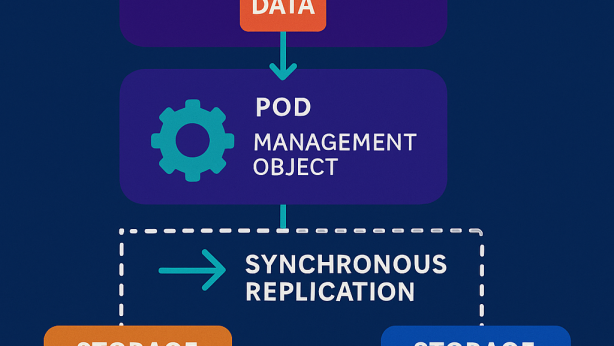Computing Device Having Sensor With Integrated Antenna
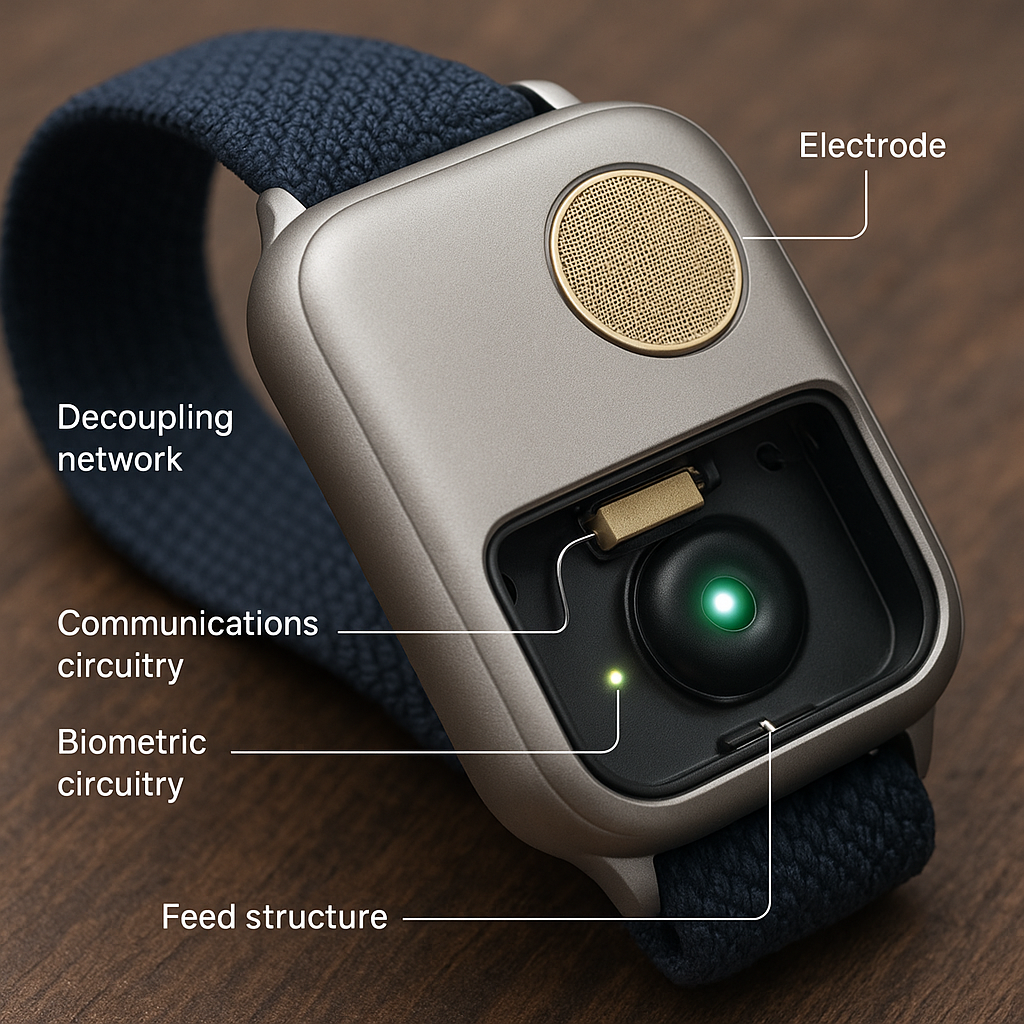
Invented by Yang; Zhenchao, Wang; Zheyu
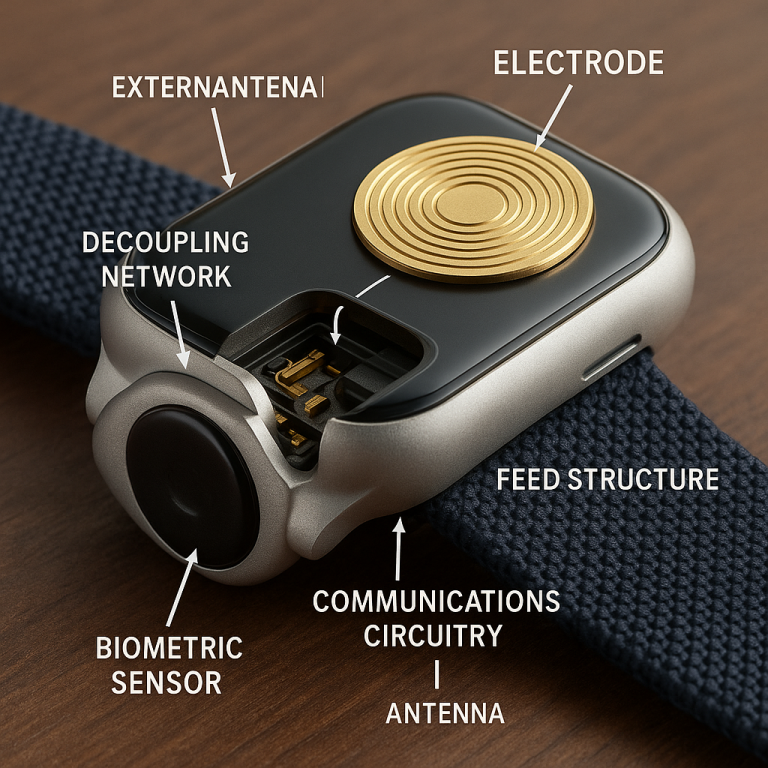
Welcome! Today, we’re taking a close look at a fascinating patent application that rethinks how wearable devices work. This invention is about putting a biometric sensor and an external antenna together in one small, smart part. It’s more than just clever engineering—it’s the kind of breakthrough that can change how we connect, track health, and design tiny gadgets. Let’s break it all down, in simple terms, step by step.
Background and Market Context
Wearable devices are everywhere these days. Whether it’s a smart watch, a fitness band, or a ring that measures your sleep, these gadgets are becoming a big part of our lives. We wear them to track our steps, monitor our heart rate, or even get messages from our phones. As people want more from these devices, the companies making them have to figure out how to pack more features into tiny packages.
When you think about a wearable, you probably picture something small and lightweight. That’s on purpose—no one wants a heavy, bulky device on their wrist. But squeezing in all the parts needed—like sensors, antennas for wireless signals, batteries, and screens—is really hard. Each part takes up space, and space is very limited.
One big job for these devices is talking to other gadgets. Maybe your smart watch sends your heart rate to your phone, which saves it for you to look at later. To do this, wearables use wireless signals like Bluetooth, WiFi, or even LTE (the same signal your smartphone uses to talk to the internet without WiFi). For all these signals, the device needs antennas.
But here’s a problem: antennas need room to work well. They don’t like being too close to metal or other electronics because that can mess up the signal. In a small watch, there isn’t much room to keep antennas away from these things. This can make the signal weak, or sometimes it doesn’t work at all. Some companies try to fix this by making the device bigger, but that’s not what users want.
At the same time, people want their wearables to do more than just send and receive data. They want to track more health data, like measuring body fat, checking for stress, or even figuring out blood pressure. These features need sensors, and each sensor takes up space, too.
So, makers of wearables are in a tough spot: they need to add more features without making the device any bigger. They also need to keep the battery big enough to last all day and fit in a nice screen. This is where the patent we’re discussing today comes in.
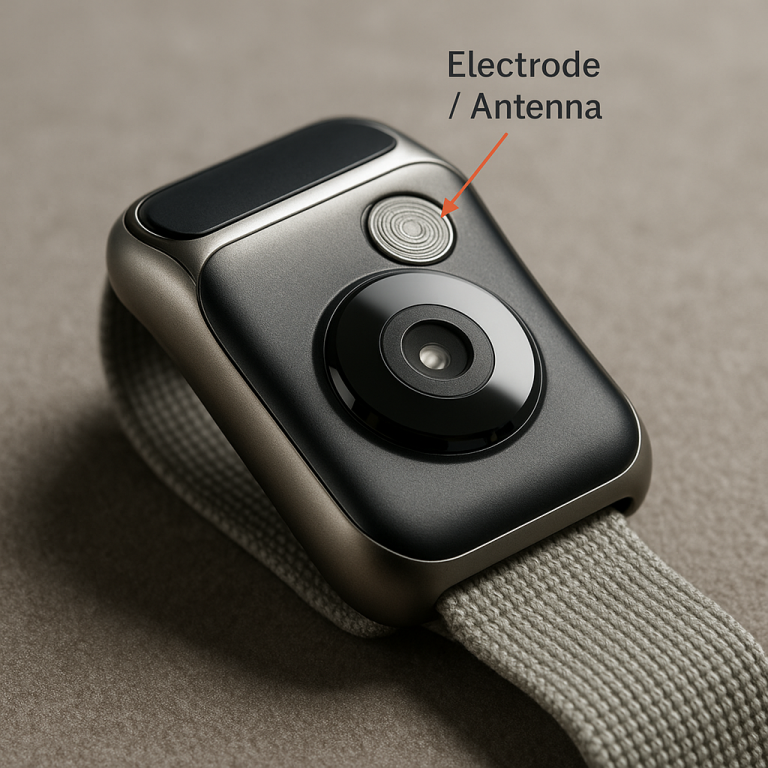
This new invention is about combining two important parts—a sensor and an antenna—into one. By doing this, it saves space, cuts down on parts, and can even help lower costs. It could help wearable makers design devices that are slimmer, lighter, and more packed with features than ever before.
This is a big deal. Wearables are not just a trend—they’re a growing part of the tech world. As more people care about their health and want to be connected all the time, smart, space-saving solutions like this are going to become very important.
Scientific Rationale and Prior Art
Let’s dig into why this invention matters from a technical point of view. To understand it, we need to look at how current wearable devices work, and what their limitations are.
Most wearables use antennas that are hidden inside the device. These antennas send and receive radio signals—think of them as the device’s “ears” and “voice” for talking to your phone, the internet, or other gadgets. But because the device is small, the antenna often sits close to other parts, like metal housing, batteries, or screens. This can cause interference and make the antenna less sensitive. When that happens, the device might drop connections, have slower data, or even fail to meet the requirements of wireless providers.
To make things harder, many wearables need to use several different wireless standards. For example, your smart watch might use Bluetooth to talk to your phone, WiFi to download updates at home, LTE to send data when you’re out, and maybe even GPS to track your runs. Each of these uses a different frequency band, and sometimes they need different antennas. Trying to make one antenna work for everything can lead to poor performance. Adding more antennas isn’t easy either, because of limited space.
Meanwhile, sensors that collect biometric data—like those that measure your body’s resistance to a tiny electric current (called bioimpedance)—also need to be placed in the device. These sensors usually work best when they’re placed in a spot where your finger or skin can touch them, but sometimes they also have to avoid constant skin contact to improve accuracy.
There have been some attempts in the past to combine antennas with other parts, or to hide them in the device’s band or case. Some companies put the antenna in the watch band, but bands are often swapped out or made of different materials, which can ruin the signal. Others have tried using the device’s case as the antenna, but this can affect wireless performance and even make the device uncomfortable.
Another problem with combining sensors and antennas is that they use different types of signals. Antennas use high-frequency radio signals, while sensors often measure low-frequency electrical signals from your body. If you connect both to the same piece of metal, the signals can get mixed up—making both the wireless and the sensor unreliable.
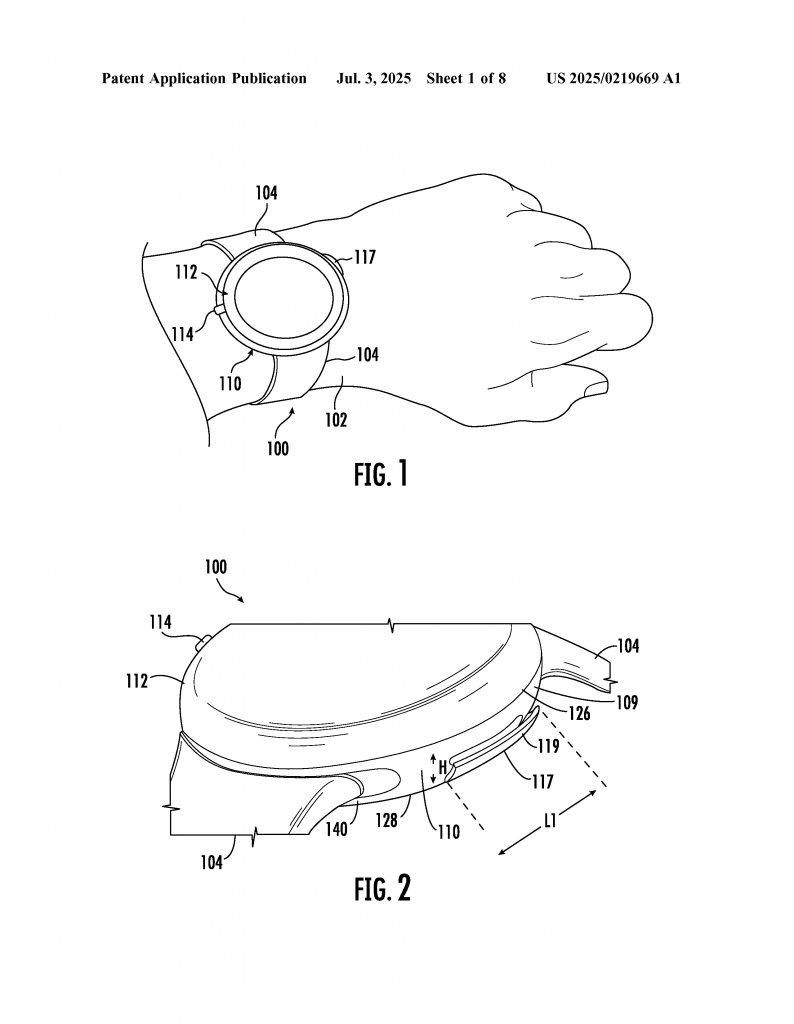
Some previous designs tried to get around this by using switches that connect the part to either the sensor or the antenna, but not both at the same time. This means you can’t use both features together, which isn’t very user-friendly. If you want to check your health data while also getting a strong wireless signal, you’re out of luck.
In summary, the main problems with current technology are:
– Not enough space for all the antennas and sensors needed
– Mixing signals causes interference
– Can’t use sensor and antenna at the same time
– Performance drops when antennas are too close to other parts
– Difficulty meeting wireless provider rules for coverage and signal strength
The new invention in this patent tries to solve all these problems at once by creating a single part that does both jobs, and by using smart electronics to keep the signals separate. This is a step beyond what has been tried before.
Invention Description and Key Innovations
Now, let’s explore how this invention works and why it’s special.
At the heart of this patent is something called an “integrated electrode.” Think of it as a single piece of metal that can do two jobs: it acts as a sensor to measure information from your body, and it also acts as an antenna to send and receive wireless signals. This electrode is placed on a part of the device that does not touch your skin all the time—usually next to the display or on the side of the watch case.

Inside the device, the electrode is connected to the main circuit board using a “feed structure.” This is just a way of saying it’s plugged in securely to the electronics inside, using strong and reliable connectors. Between the electrode and the inside circuits, there’s a special “decoupling network.” This is a group of small parts—like resistors, capacitors, and inductors—that act like traffic cops, making sure the right signals go to the right place.
Here’s how it works:
– When the electrode picks up a high-frequency radio signal (like Bluetooth or WiFi), the decoupling network sends that signal to the communications part of the circuit.
– When the electrode picks up a low-frequency electrical signal (like the one your body gives off for a health measurement), the decoupling network sends that signal to the sensor part of the circuit.
The magic is that both things can happen at once. You can be measuring your body’s bioimpedance (which helps calculate body fat or hydration) while also using the antenna to send your data to your phone. This is a big improvement over past designs, which made you pick one or the other.
The invention also uses “impedance matching circuitry.” This helps make sure that signals travel smoothly from the electrode to the rest of the electronics, without bouncing back or getting lost. This is important for both the antenna and the sensor to work well.
Another clever feature is that the electrode is separated from the device housing by a special electrostatic discharge (ESD) material. This keeps static electricity from damaging the electronics, and also helps keep signals clean and strong.
The electrode is designed with careful measurements—its length, width, and how far it sticks out from the case are all chosen to make it easy for your finger to touch, but not so big that it will touch your skin all the time or make the watch uncomfortable.
In some versions, the electrode is split into two parts, with a spacer in between. This lets the device use both parts as separate antennas for special wireless signals, like ultra-wideband (UWB), which is used for things like precise location tracking. By having two antennas, the device can do things like figure out exactly which direction a signal is coming from—a feature that’s very useful for tracking lost items or for advanced fitness tracking.
The device can also have both internal and external antennas, with smart switches inside that pick the best antenna for each job. If the external antenna (the one that’s also the sensor) gets a better WiFi signal, the device can switch to using it. If the internal antenna is better for Bluetooth, it can use that one instead. This makes the device flexible and gives the user the best possible connection without them having to do anything.
The patent also covers the method for making all this work. It explains how to connect the electrode, how to lay out the electronics, and how to keep the signals from interfering. It mentions using a “dielectric material” (an insulator) between the electrode and the case for safety and better performance.
The result is a wearable device that can do more, in less space, with fewer parts. It can track your health, keep you connected, and even adapt to different situations—all while staying small and good-looking.
Here are some of the key benefits of this invention:
– Space-saving: By combining the sensor and antenna, the device can stay small and slim.
– Cost-effective: Fewer parts mean lower manufacturing costs.
– Better performance: The decoupling network keeps signals strong and clear.
– Simultaneous operation: You can use health features and wireless features at the same time.
– Flexibility: Works with many wireless standards (Bluetooth, WiFi, LTE, UWB, GPS, etc.)
– Customizable: Electrode size and shape can be changed for different devices.
– Safety: ESD protection keeps electronics safe from static shocks.
– Advanced features: With split electrodes, the device can even do advanced tasks like direction finding.
This makes the invention a strong step forward for wearable technology. It solves problems that have held back device makers and opens the door to new features that customers will love.
Conclusion
Putting a biometric sensor and an external antenna together into a single part is a smart, elegant solution for wearable devices. It solves the big problem of space inside small gadgets, lets devices do more at once, and helps keep wireless signals strong and reliable. With this new approach, wearable makers can build smaller, better, and more affordable devices, giving users more features without making compromises. This patent shows how creative thinking and careful engineering can move the whole industry forward, making wearable devices even more useful in our daily lives. As technology keeps pushing forward, ideas like this will help shape the next wave of smart, connected products.
Click here https://ppubs.uspto.gov/pubwebapp/ and search 20250219669.

